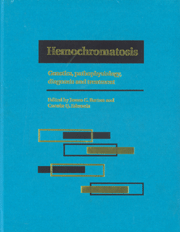Book contents
- Frontmatter
- Contents
- List of contributors
- Foreword
- Part I Introduction to hemochromatosis
- Part II Genetics of hemochromatosis
- Part III Metal absorption and metabolism in hemochromatosis
- Part IV Diagnostic techniques for iron overload
- Part V Complications of iron overload
- 21 Mechanisms of iron toxicity
- 22 Iron as a carcinogen
- 23 Clinical spectrum of hepatic disease in hemochromatosis
- 24 The arthropathy of hemochromatosis
- 25 Diabetes mellitus and hemochromatosis
- 26 Non-diabetic endocrinopathy in hemochromatosis
- 27 Cutaneous manifestations of hemochromatosis
- 28 Cardiac abnormalities in hemochromatosis
- 29 Estimate of the frequency of morbid complications of hemochromatosis
- 30 Juvenile hemochromatosis
- Part VI Therapy of hemochromatosis and iron overload
- Part VII Infections and immunity in hemochromatosis
- Part VIII Hemochromatosis heterozygotes
- Part IX Relationship of hemochromatosis to other disorders
- Part X Animal models of hemochromatosis and iron overload
- Part XI Screening for hemochromatosis
- Part XII Hemochromatosis: societal and ethical issues
- Part XIII Final issues
- Index
24 - The arthropathy of hemochromatosis
from Part V - Complications of iron overload
Published online by Cambridge University Press: 05 August 2011
- Frontmatter
- Contents
- List of contributors
- Foreword
- Part I Introduction to hemochromatosis
- Part II Genetics of hemochromatosis
- Part III Metal absorption and metabolism in hemochromatosis
- Part IV Diagnostic techniques for iron overload
- Part V Complications of iron overload
- 21 Mechanisms of iron toxicity
- 22 Iron as a carcinogen
- 23 Clinical spectrum of hepatic disease in hemochromatosis
- 24 The arthropathy of hemochromatosis
- 25 Diabetes mellitus and hemochromatosis
- 26 Non-diabetic endocrinopathy in hemochromatosis
- 27 Cutaneous manifestations of hemochromatosis
- 28 Cardiac abnormalities in hemochromatosis
- 29 Estimate of the frequency of morbid complications of hemochromatosis
- 30 Juvenile hemochromatosis
- Part VI Therapy of hemochromatosis and iron overload
- Part VII Infections and immunity in hemochromatosis
- Part VIII Hemochromatosis heterozygotes
- Part IX Relationship of hemochromatosis to other disorders
- Part X Animal models of hemochromatosis and iron overload
- Part XI Screening for hemochromatosis
- Part XII Hemochromatosis: societal and ethical issues
- Part XIII Final issues
- Index
Summary
Introduction
Arthropathy is one of the common and early clinical manifestations of hemochromatosis. Described in 1964, hemochromatosis arthropathy was described as a form of arthritis with distinctive synovial membrane changes and characteristic joint distribution and radiographic findings. It has been increasingly recognized as a clinical feature of hemochromatosis that sometimes leads to early diagnosis and treatment before irreversible iron-associated injury occurs to the liver and other organs.
Pathogenesis
Morphologic studies of joints affected with hemochromatosis arthropathy reveal iron deposits in the synovium and cartilage and degenerative changes in the articular cartilage. Iron deposition is generally most prominent in the synovial lining layer (Fig. 24.1). Proliferation of the synovial lining cells is mild or moderate, and characteristically there is little deeper inflammation (Fig. 24.1). By electron microscopy (EM), aggregates of ferritin are visualized predominantly in the synovial type B (synthetic) cells and, to a lesser extent. in the synovial type A (phagocytic) cells, (Fig. 24.2). Nearly all iron detected by EM and light microscopy is intracellular, and most cells that contain iron appear intact. Ferritin granules occur diffusely throughout the cytoplasm and formaggregates between the cisterns of rough endoplasmic reticulum. When iron loading is severe, macrophages also contain deposits. However, the presence of stainable iron in joint tissues is also found in rheumatoid arthritis, osteoarthritis, pigmented villonodular synovitis, hemophilia, and hemarthrosis. In these latter disorders, iron deposition tends to occur more in deep macrophages, although increased iron may also occur in type B cells. In patients with hemochromatosis, iron deposition in chondrocytes of the articular cartilage is a common but not invariable finding, and ferritin particles occur in intact and degenerating chondrocytes (Fig. 24.3).
- Type
- Chapter
- Information
- HemochromatosisGenetics, Pathophysiology, Diagnosis and Treatment, pp. 258 - 267Publisher: Cambridge University PressPrint publication year: 2000
- 5
- Cited by



